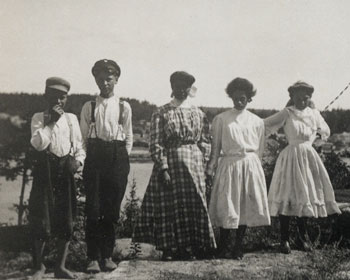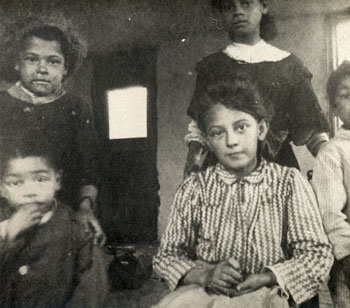A Brief History of Malaga Island
by Tom Seymour

Harold McKinney and John Murphy, Jr (left to right), and three unidentified students from the Malaga Island school, circa 1910. Photo courtesy of Peter Roberts
In the late 1800s, Francis Galton, an Englishman interested in genetics and a relative of Charles Darwin, coined the term, “eugenics.” The root of the word stems from the Greek and means “origin” and “good birth.”
Galton suggested that the English elites were of a superior intelligence and that that intelligence was passed down through succeeding generations. Galton felt that by selective breeding, humans could be custom-designed for only the best traits. By way of arranged marriages, Galton determined that it would only take a few generations of breeding to create a super race of humans.
By the early 21st century, the concept of eugenics became popular in the United States. In 1910, Charles Davenport began the “Eugenics Record Office.” This facility collected data on people’s roots and also, their personal and physical traits. As opposed to the English form of eugenics, which sought to rid mankind of “unfit” individuals by breeding for desirable traits, American eugenic adherents believed undesirable traits such as mental illness, the state of being poor, criminal behavior and promiscuity could be eradicated by segregating and institutionalizing the poor, feeble, sick and the handicapped.
So in the spirit of eugenics, America began a campaign to “breed out” undesirable individuals. Part of this effort included forced sterilization. Indiana and California were the first states to pass forced sterilization laws, but other states soon followed and in the end, 30 states had enacted sterilization programs. Indeed, Supreme Court Justice Oliver Wendell Holmes famously stated, “It is better for all the world, if instead of waiting to execute degenerate offspring for crime, or to let them starve for imbecility, society can prevent those who are manifestly unfit from continuing their kind…Three generations of imbeciles is enough.”
By the time it was all over, 64,000 innocent Americans were forcibly sterilized.
Maine Eugenics
Maine did not escape the lunacy of eugenics. In 1912, residents of a small Midcoast island felt the sting of racism and just plain ignorance.
Beginning in the early 1860s, Malaga Island, a 42-acre, ¼-mile- wide by ½- mile-long island off the coast of Phippsburg, was inhabited by a working community populated by white, black and mixed-race inhabitants. The community more than likely, according to the Maine State Museum, traced its origins to one Benjamin Darling, an African-American man who purchased nearby Horse Island in 1794.
Darling’s progeny and their descendents then spread out from Horse Island to settle on other nearby islands, including Malaga Island. The first Darling descendents to settle on Malaga Island are thought to be Henry and Fatima Darling Griffin, along with their family. The Griffins settled on the east side of the Island.
The Griffins and those who followed them built a solid, hard-working community, whose members made most of their living from the sea. Some others worked as carpenters and masons for mainland residents.

Unidentified children on Malaga Island, Maine, circa 1910. Photo courtesy of Peter Roberts
Some of the couples on the island were never formally married and some of the children were unschooled, at least until Christian missionaries George and Lucy Lane from Malden, Massachusetts visited Malaga Island in 1906. The Lanes channeled their efforts toward educating the children living on the island, eventually securing funds to establish a school and also, to provide food and clothing.
And then came the eugenics movement. Up until that point no one thought much about the people on Malaga Island. Then in the early years of the 20th century, as tourists from other states took an increased interest in Maine as a vacation site, everything changed. People on the mainland began demeaning the Malaga Islanders, referring to them as unfit. A newspaper article of the time described Malaga Island and those living there as, “Not fit for dogs. Poverty and disease, disgusting and pitiable.”
Of course all this was aimed at helping Maine to put on a good appearance for the out-of-state tourists. Tourist dollars were highly sought and anything that might deter tourism was deemed unacceptable. The people of Malaga Island had to go.
Forced Exodus
What eventually transpired between the people of Malaga Island and the State of Maine marks one of the lowest points in Maine’s history.
The contrived story of Malaga Island’s inhabitants being unfit was amplified by headlines in newspapers throughout the state. Such fabricated comments as “Homeless Island of Beautiful Casco Bay – Its Shiftless Population of Half-Breed Blacks and Whites…” and “Queer Folk of The Maine Coast” garnered interest in Maine and beyond.
But because Maine’s government and the news media disapproved of the people on Malaga Island, that alone wasn’t enough to displace them and destroy their lives. Something else was needed. And that came in the form of a false presumption that Malaga Islanders were unable to help themselves and thus would have better lives if they were rounded up and made wards of the state.
The trashing in print continued, with the mantra being taken up by the well-known national publication, Harper’s Magazine.
The nearby Town of Phippsburg had as far back as the 1890s, worked at contriving ways to rid itself of the Malaga Islanders. How could the town attract tourists with these undesirables living on an island just a stone’s throw from the mainland? Efforts continued toward eviction and in 1905, the Maine government named all Malaga Island residents as wards of the state. This totally indiscriminate and probably illegal sentence sounded the death knell for the industrious and innocent residents of Malaga Island.
The now-disenfranchised Malaga Islanders were placed under the jurisdiction of the Governor’s Executive Council. George Pease of Phippsburg was appointed an agent of the state with a duty to oversee food, clothing and medical supplies destined for Malaga Island.
Maine governor Fredrick Plaisted, along with his executive council, visited Malaga Island in 1911. Following the governor’s visit, the Brunswick Times Record ran a story detailing the governor’s thoughts on Malaga Island: “The best plan would be to burn down the shacks with all their filth. Certainly the conditions are not creditable to our state, and we ought not to have such things near our front door…”

View from Malaga Island to mainland Phippsburg, circa 1910. Photo courtesy of Peter Roberts
Following the governor’s official statement, the State of Maine decided that Malaga Island was the property of the descendents of Eli Perry. The Perry family successfully petitioned to have the island’s residents evicted and on December 9, 1911, eight Malaga Islanders were committed to the Maine School for The Feeble Minded. This was despite the fact that the Islanders were no more feeble minded than those who had them committed.
The Perry family’s ownership of Malaga Island was short-lived, since the following year, the State of Maine purchased the island from Perry heirs for $400. This came with an edict that island residents must leave the island by July 1, 1912. With this demand came no assistance in finding new homes for the displaced residents. And then when George Pease visited the island to see if the evictions had been carried out, he found all the houses gone. The residents had, rather than allowing strangers to burn their homes, dismantled and removed them themselves.
As if all this wasn’t enough of a travesty, the State of Maine dug up all the graves on Malaga Island and combining 17 bodies indiscriminately in five caskets, had them reinterred in the Maine School for the Feeble Minded cemetery in New Gloucester. The school was founded in 1907 and closed in 1996. The last recorded sterilization there took place in 1983.
Too Little, Too Late
Roughly 100 years after the Malaga Island debacle, the State of Maine adopted a joint resolution condemning its actions regarding the people of Malaga Island. Then-governor John Baldacci met with Malaga Island descendents and apologized for what an earlier governor had done. Baldacci said, “I thought it was very important that I go there as governor and try as much as possible to right a wrong that had been done many years ago. I don’t think it was reflective of Maine’s history, heritage and roots.” (To read an excerpt from the 124th Maine State Legislature’s joint resolution of 2012 on Malaga Island - HP1327- See fishermensvoice.com)
Whether or not this tardy apology actually did right the long-time wrong, the people gathered at the meeting were at least partly mollified. And today, the descendents of those people who were unjustly wronged so long ago have taken an interest in their heritage and by various means, including social media, have contacted each other in order to share their feelings and history.
While the grave injustice committed back in 1911 can never be fully eradicated, the least that can happen is that, hopefully, never again will the State of Maine choose profit over the well-being of its people.
You can read an excerpt from the124th Maine State Legislature’s joint resolution of 2012 on Malaga Island - HP1327 here ![]() .
.
